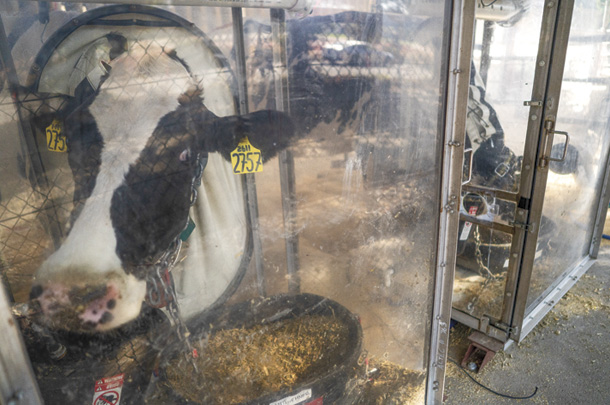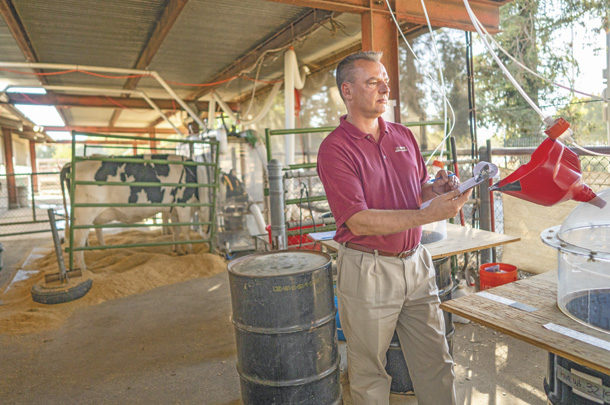When it comes to animal agriculture, one of the most exciting – and important – areas of research pertains to dietary supplements with the potential of reducing methane emissions.
Experimenting with ruminants’ diets is nothing new. Feed additives have been used for decades to improve productivity, health and other functions in dairy cattle. However, in the last decade or so, as the problem of global warming has become more pressing, the focus on the environmental impact of livestock has sharpened accordingly in the process, driving the development of supplements that can decrease the amount of methane released by cattle.
While the process of identifying, studying and evaluating feed additives is a highly scientific one, some of the supplements themselves are ordinary household names. For example, when cows are given a supplement of seaweed or some manner of essential oils, belches – and possibly manure – contain less of the powerful greenhouse gas methane.
Scientists know this because of intricate research that takes place in labs (in vitro) and later involves bringing live animals into the studies for in vivo experiments. In vitro fermentation consists of incubations of substrates with rumen fluid and measuring the amount of methane in the headspace gas composition and total gas production. These “test-tube” studies are valuable for determining if the study should be expanded to include live animals. Advancing to the next step is essential, as not all additives with positive in vitro results behave the same way in vivo.
Once a feed additive has shown promise in reducing methane emissions in vitro, it moves to in vivo trials. Various experimental designs can be applied during in vivo investigation depending on the objective, methane measurement technique and number of animals available for research. Most institutional animal-care committees insist on using the least amount of animals for in vivo experiments. This is typically determined using a power analysis, a calculation of the number of animals required to detect a certain level of difference between control (untreated) animals and those that receive feed additives.
 Both in vitro and in vivo experiments are conducted to determine the level of reduction of methane emissions from feed additives. Photo provided by Frank Mitloehner.
Both in vitro and in vivo experiments are conducted to determine the level of reduction of methane emissions from feed additives. Photo provided by Frank Mitloehner.The most common experimental design is known as “Latin square.” It involves rotating animals in the study such that each one will at some point represent control and various levels of feed additives. This allows the assessment that the results are applicable to cattle in general by taking into account animal-to-animal variation. A mean value is then calculated for the entire experiment, which typically lasts 12 weeks or more, and the level of reduction of methane emissions (if any) is then determined.
In order to further determine the efficacy of a feed additive, similar experiments using the same feed additive are typically conducted all over the world. All data using the feed additive can then be put together and analyzed in a meta-analysis to determine overall efficacy and conditions under which efficacy is increased or diminished.
For example, the feed additive 3-nitrooxypropanol has been studied and reported in 20-plus experiments. A meta-analysis of all the studies shows that its overall effectiveness is about 30% across species and diets. However, it is about 40% effective in dairy, its effectiveness going up with increasing doses and diminishing as dietary fiber increases.
The promising case of seaweed began simply and organically. A Canadian farmer noticed his cattle that foraged seaweed seemed to do well. He shared his experience with scientists, who collected various types of seaweed and screened them to determine methane-reducing potential (if any) using in vitro fermentation techniques. Red seaweed, Asparagopsis taxiformis, showed a huge reduction in those in vitro trials. Further studies showed that this species contains active ingredients known to inhibit methane formation. An in vivo trial was then conducted for the first time at the University of California – Davis using lactating dairy cattle to determine whether the in vitro results would prove true in vivo.
The results were unexpectedly high levels of efficacy (up to a 67% reduction). Because the trial involved exposing animals to the seaweed for only two weeks at a time, the same team designed a follow-up study to extend the supplementation of seaweed for 21 weeks with a varied diet. That led to an even higher efficacy – up to 80% – by the end of the 21-week trial, although efficacy was dependent on the fiber concentration of the diet. A similar study in Australia demonstrated efficacy of up to 98%. Once we have more studies, a meta-analysis must be conducted to determine overall effectiveness and the conditions that influence the efficacy of seaweed.
Essential oils have likewise demonstrated desirable effects on ruminal fermentation and the potential for reducing enteric methane emissions. They also may be more accessible for the time being than seaweed. Essential oils are secondary plant metabolites that function to help the plant ward off biotic stressors that include micro-organisms. Research has shown that blends of specific essential oils can lead to reductions in methane while enhancing animal performance, such as milk yield.
One such blend of essential oils is the commercially available Agolin Ruminant, which is comprised of eugenol, coriander seed oil and geranyl acetate. A meta-analysis of Agolin showed that the supplement significantly improves milk yield and leads to decreases in methane production and methane intensity when given to dairy cows at a rate of one gram per head per day (1 g/head/day).
Researchers at UC – Davis conducted an in vivo trial in which mid-lactation dairy cows were supplemented with 1 g/head/day of Agolin for 56 days. Though the researchers did not determine direct improvements in animal performance, they noticed significant reductions in methane intensity. This added to the existing literature that suggests that Agolin may elicit favorable reductions in methane emissions.
Work continues, but based on results thus far, we seem to be on the path to demonstrating that more is indeed less.








